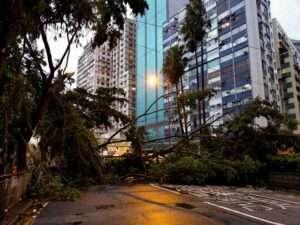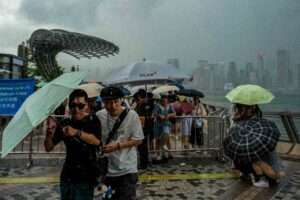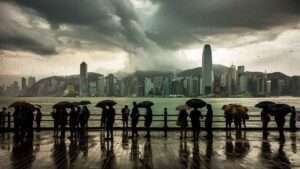Hong Kong Weather: Your Weather Forecast Guide
Are you curious about the weather in Hong Kong, known as “Asia’s World City”? We’re here to share our local insights. Our guide will help you plan your trip with the latest weather forecast.
Learn about Hong Kong’s subtropical climate and the best times to visit. Our guide covers everything from sunny beach days to cozy winter outings. Stay ahead of the weather with our month-by-month forecast.
Understanding Hong Kong's Unique Climate Patterns
Hong Kong’s climate is a mix of subtropical and monsoon effects. This creates a weather pattern unlike any other. Let’s dive into what makes Hong Kong’s climate so special.
Subtropical Climate Characteristics
Hong Kong is on China’s southern coast. It has a subtropical climate because of its oceanic location. We see warm and humid weather most of the year. Temperatures range from 18°C (64°F) to 29°C (84°F).
Monsoon Influence on Local Weather
這 monsoon system is a key part of Hong Kong’s climate. In summer, the East Asian monsoon brings heavy rain and high humidity. Winter, however, is cooler and drier, thanks to the continental monsoon.
Temperature Variations Throughout the Year
- Spring (March to May): Mild and pleasant, with average temperatures around 22°C (72°F).
- Summer (June to August): Hot and humid, with temperatures often reaching the low 30s Celsius (high 80s Fahrenheit).
- Autumn (September to November): Cooling down, with average temperatures of 25°C (77°F).
- Winter (December to February): Relatively cool and dry, with temperatures dipping to around 16°C (61°F).
Knowing about Hong Kong’s subtropical climate 和 monsoon patterns is key. It helps us prepare for and enjoy the city’s varied weather all year.
Best Times to Visit Hong Kong for Perfect Weather
Planning a trip to Hong Kong means thinking about the weather. This city has a varied climate, making it great to visit at different times. Knowing the best time to visit Hong Kong 和 Hong Kong average temperature helps you have a comfortable trip. You’ll get to see the city’s amazing sights and attractions.
這 best time to visit Hong Kong is spring and fall. The weather is mild, with temperatures between 70°F and 80°F. This makes it perfect for outdoor fun and exploring.
For the best weather, visit Hong Kong in:
- March to May
- October to November
These months have the best weather. You can enjoy the city’s culture, landscapes, and attractions without the summer heat or winter cold.
“The weather in Hong Kong is truly exceptional, making it a year-round destination. However, the spring and fall seasons are undoubtedly the best times to visit and enjoy the city’s natural beauty.” – Local Hong Kong Resident
Traveling during the best time to visit Hong Kong 和 Hong Kong average temperature ensures great weather. You’ll have unforgettable experiences in this vibrant city.

Hong Kong Weather: A Month-by-Month Breakdown
Hong Kong’s weather is as varied as the city itself. Whether you’re planning a trip during peak seasons or off-peak, knowing the monthly forecast is key. It helps you enjoy your visit to the fullest.
Peak Tourist Seasons
The best times to visit Hong Kong are from October to December 和 March to May. These months have mild weather, less rain, and fewer people. They’re perfect for those looking for the Hong Kong weather forecast at its finest.
Off-Peak Weather Benefits
Visiting Hong Kong in summer or winter has its perks. Summer, from June to August, is great for beach and outdoor fun. Winter, from December to February, is perfect for festive vibes and indoor activities.
Special Weather Considerations
- Typhoon season is from June to October. Be ready for weather changes then.
- 這 rainy season is from May to September. Don’t forget your rain gear.
- Hong Kong’s climate is subtropical. It’s always humid. Wear light, breathable clothes.
Knowing the Hong Kong weather forecast 和 monthly weather patterns helps plan your trip. You can match your visit with your favorite activities and weather, making your trip unforgettable.
Spring in Hong Kong: March to May Guide
Spring in Hong Kong is a welcome break from the hot summers. From March to May, the weather is mild, with some rain and lots of activities. Let’s look at what makes spring in Hong Kong special and how to enjoy it.
Spring in Hong Kong means temperatures between 20°C and 26°C. Mornings and evenings are cooler, while afternoons are warm. Rain showers happen often, making the air feel fresh after winter.
With spring activities in full swing, it’s a great time to get outside. Here are some top things to do:
- Walk through the city’s parks and gardens, enjoying the flowers and greenery.
- Hike on scenic trails like the Dragon’s Back or Lamma Island, with amazing views.
- Go to outdoor cultural events and festivals, like the Hong Kong Dragon Boat Festival.
- Try the local street food and markets, with their spring flavors.
- Have a picnic in a beautiful public space, enjoying the spring air.
Whether you love nature, culture, or just the weather, Hong Kong has plenty to offer in spring.
Summer Essentials: Navigating Hong Kong's Hottest Months
Summer in Hong Kong can be tough with high heat and humidity. But, with the right tips, you can enjoy the city’s warm months.
Heat Index and Humidity Levels
The summer heat in Hong Kong is made worse by high humidity. This creates a hot and sticky atmosphere. It’s key to drink lots of water, wear light clothes, and find cool places when it’s too hot.
Summer Storm Patterns
Summer in Hong Kong means sudden thunderstorms and heavy rain. These storms can come fast, bringing strong winds and flash floods. Always check the weather forecast and have a plan to find shelter when storms hit.
Beach Weather Guidelines
- Enjoy Hong Kong’s beautiful beaches, but watch out for the heat and sun.
- Use sunscreen, wear a hat, and choose light clothes to protect from the sun.
- Drink water and rest in the shade to avoid getting too hot.
- Know about rip currents and listen to lifeguards for a safe beach day.
Knowing about Hong Kong’s summer heat, humidity levels, 和 storm patterns helps you enjoy the Hong Kong weather in summer. With the right steps and flexibility, you can have a great time in the city’s beach weather and summer activities.
When typhoon or monsoon comes to Hong Kong, weather can be very bad:




Autumn Adventures: October to November Weather
As summer fades, Hong Kong becomes a charming autumn spot. From October to November, the Hong Kong weather in autumn is ideal for fall activities. The weather is mild, making it perfect for seeing the city’s lively attractions.
The autumn temperature in Hong Kong is just right. Daytime is in the mid-20s Celsius (70s Fahrenheit), a nice break from summer. At night, it cools down to the low 20s Celsius (upper 60s Fahrenheit), ideal for outdoor dining or walks.
The humidity is also lower, adding to the autumn charm. No more hot, humid days. Instead, there’s a cool, dry air that’s lovely to breathe. This makes autumn great for fall activities like hiking, cycling, and visiting famous spots.
Autumn’s Optimal Outdoor Conditions
- Comfortable temperatures in the 70s Fahrenheit (mid-20s Celsius)
- Low humidity levels, providing a refreshing atmosphere
- Ideal for outdoor activities like hiking, cycling, and sightseeing
“Hong Kong in autumn is simply magical. The weather is perfect for exploring the city’s vibrant streets and natural wonders.”
Planning a trip to Hong Kong? Autumn is a great time to visit. With its Hong Kong weather in autumn and plenty of fall activities, it’s a wonderful season to see the city’s beauty.
Winter in Hong Kong: December to February Forecast
As the year ends, Hong Kong’s weather changes in December, January, and February. We’ll look at the temperature changes and find the best winter activities for this season.
Temperature Fluctuations
Hong Kong’s winter weather is a mix of mild and cool temperatures. Daytime highs are usually 18°C (64°F) to 15°C (59°F). Nighttime lows can be as low as 12°C (54°F).
Now and then, cold snaps might lower temperatures to single digits. But these are brief, and winter in Hong Kong remains pleasant.
Winter Activities and Planning
這 Hong Kong weather in winter is a cool break from the hot summer. It’s a great time for winter activities in the city. You can check out holiday markets, light displays, and cozy indoor spots.
Here are some tips for your winter trip:
- See the lights and decorations at places like Harbour City Christmas Wonderland and Hong Kong Disneyland Winter Holiday.
- Try warm local food at Hong Kong tea houses and cafes.
- Go hiking in the countryside or walk along the waterfront promenades.
- Explore the night markets and find special souvenirs.
Plan well and enjoy the Hong Kong weather in winter. You’ll have a memorable trip with lots of winter activities and fun experiences.
Managing Hong Kong's High Humidity
Living in Hong Kong can be tough, especially with the high humidity. The city’s subtropical climate means hot summer days and sticky nights. It’s important to find ways to stay cool and healthy.
Dressing right is key. Wear lightweight, breathable fabrics like cotton and linen to stay cool and dry. Avoid heavy, synthetic materials that hold moisture. Using a good dehumidifier at home and work can also help.
Staying hydrated is crucial. Drinking lots of water helps our bodies handle the humidity. Try to avoid too much caffeine and alcohol, as they can dehydrate us.
When going outside in the humid months, carry a portable fan or mini-mister. Look for shaded areas and air-conditioned spots for relief from the heat.
By using these tips, we can better handle Hong Kong’s humidity. Being adaptable and prepared helps us enjoy the city, even when it’s hot and humid.
Rainfall Patterns and Monsoon Seasons
Hong Kong’s weather is shaped by its tropical and subtropical climate. This leads to wet and dry seasons. The monsoon season brings heavy Hong Kong rainfall, causing worries about flood-prone areas. Knowing these patterns is key for locals and visitors.
Wet Season Preparations
這 monsoon season in Hong Kong lasts from May to September. July and August are the wettest months. Expect heavy downpours and thunderstorms, with daily rainfall over 100mm.
To get ready for the wet season, do the following:
- Ensure proper drainage around your home or accommodation
- Have a reliable umbrella or rain jacket on hand
- Be aware of weather forecasts and flood warnings
- Plan indoor activities for particularly rainy days
Flood Prone Areas
Hong Kong’s hilly terrain and urban development make some areas more prone to flooding. Low-lying neighborhoods like Sai Kung and Sha Tin are at risk of flash flooding. Be aware of these flood-prone areas and plan your activities and transportation during the monsoon season.
Extreme Weather Events and Typhoon Season
Hong Kong’s subtropical climate comes with its own set of weather challenges. The typhoon season is especially noteworthy. From June to October, our city faces the threat of powerful tropical cyclones.
Typhoon warnings and preparedness are crucial during this time. The Hong Kong Observatory closely watches the weather and alerts us when a typhoon is near. This lets everyone take the right steps to stay safe.
Navigating Typhoon Warnings
It’s important to understand the different typhoon warning signals. The Observatory uses a 10-level system to show how severe a storm is. A signal of 8 or above means it’s time to take action.
- Tropical cyclone signal No. 1: Standby
- Tropical cyclone signal No. 3: Strong wind
- Tropical cyclone signal No. 8: Gale or storm
- Tropical cyclone signal No. 10: Hurricane
By listening to these warnings and following local advice, we can reduce the risks. This way, we can safely get through the typhoon season.
What to Pack for Different Weather Conditions
When planning your trip to Hong Kong, think about the weather. The summer is warm and humid, while autumn is mild and breezy. The right clothes can greatly improve your trip. Here are some tips for packing for Hong Kong’s weather.
Seasonal Packing Lists
It’s important to consider the weather when packing for Hong Kong. Here are some seasonal packing ideas:
- Spring (March to May): Pack light, breathable clothes like t-shirts and blouses. Remember to bring an umbrella or rain jacket for rainy days.
- Summer (June to August): Choose loose, airy clothes like tank tops and shorts. This will help you stay cool in the heat and humidity.
- Autumn (October to November): Bring longer sleeves, pants, and light sweaters or cardigans for the cooler weather.
- Winter (December to February): Pack warm items like coats, scarves, and gloves. Also, bring thermal base layers to stay warm.
Weather-Appropriate Clothing Tips
Here are some tips to make sure you’re dressed for Hong Kong’s weather:
- Choose lightweight, breathable fabrics like cotton, linen, and moisture-wicking synthetics. They help you stay cool in the heat and humidity.
- Carry a light, packable rain jacket or umbrella. They can protect you from sudden rain showers.
- Wear comfortable, well-cushioned shoes. They’re good for walking on wet or uneven surfaces.
- Bring versatile pieces that can be layered. For example, a light sweater or scarf. They help you adjust to changing temperatures.
By planning and packing the right clothes, you’ll be ready for Hong Kong’s weather. Enjoy your trip!
Local Weather Resources and Forecast Apps
In Hong Kong, we have many reliable weather resources and apps. They help us know the current weather and what’s coming. This lets us plan our days better and enjoy the city’s weather.
The Hong Kong Observatory is the city’s weather expert. Their website has lots of info on temperature, rain, humidity, and wind. Their app, “MyObservatory,” gives us updates, radar images, and warnings. Apps like “WeatherPro” and “Dark Sky” also offer detailed forecasts and alerts for Hong Kong.
Using these tools, we can keep up with Hong Kong’s weather. This helps us decide when to visit places or what to wear. With this info, we can enjoy the city’s weather fully and have great experiences.